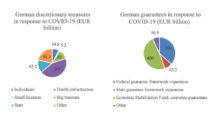Zoe johnson
Germany’s response to COVID-19 has been widely praised as a model for pragmatic, effective governance. As of 25 June, Europe’s largest economy has seen 193 807 cases and 9 012 deaths, having tested 5 412 655 people. A meaningful COVID-19 response requires actions: lockdown, testing, personal protective equipment (PPE) procurement, and then reopening. The effectiveness of these actions depends on mechanisms: fiscal capacity, logistical coordination, and pre-existing infrastructure. Germany’s success is the result of well-established mechanisms that are coordinated by appropriate levels of government in a decentralized federal model.
First, the country’s well-established fiscal capacity justified economic intervention in response to the virus, which in turn enabled a strict federal lockdown. Chancellor Merkel’s Christian Democratic Union has run a balanced budget since 2013, reducing the country’s debt-to-GDP ratio from 80 percent to 60 percent since 2010. On 25 March, the Bundestag passed a supplementary budget providing EUR 453.3 billion (USD 517.2 billion) in discretionary spending. Approximately half expands unemployment benefits, state funding, and social security. The other half establishes the Economic Stabilization Fund, money set aside for the acquisition of capital instruments and the refinancing of a state development bank. As in other advanced economies, the bulk of the German economic stimulus comes in the form of a EUR 819.7 billion (USD 935.0 billion) expansion of liquidity guarantees.

Second, Germany’s sixteen federal states’ extensive constitutional powers over freedom of assembly, public health, and public welfare provided the logistical coordination required for lockdown. As early as 26 February, the district of Heinsberg in North Rhine-Westphalia closed public spaces in response to an outbreak during the Carnival season. By the time the federal government announced the implementation of mandatory social distancing measures on 16 March, Bavaria was already under a state-wide lockdown and had issued a state of emergency. Without waiting for central approval, many states acted ahead of the curve, keeping infection chains short and enabling comprehensive local contact tracing.
Third, a combination of fiscal capacity, logistical coordination, and pre-existing infrastructure enabled the country to conduct extensive testing. The federal government helped finance tests through legislation, making it mandatory for statutory health insurance to cover the full cost of diagnostic tests and antibody tests for recovered people. Strong state bureaucracies aided with the logistics of rapid testing expansion—in Bavaria, public school teachers were reassigned to administrative roles at health departments. Unlike large centralized countries such as the United Kingdom, Germany has a decentralized network of over 200 labs consisting of hospitals, universities, and private sector facilities. Considering that most universities are owned by state governments, the early expansion of testing further demonstrates how state power to respond without central approval has defined the country’s success.
Notwithstanding these successes, the federal government has been handicapped by institutional weaknesses, defined by an absence of mechanisms. Prior to the pandemic, nearly 80 percent of German hospitals participated in group purchasing organizations for PPE. However, in an effort to ensure fair and stable prices, the federal government announced in February that it would centralize the procurement and stockpiling of PPE and ventilators. This move, alongside a concurrent expansion of the Ministry of Health’s powers, was met with stark criticism. The rollout of the centralized procurement scheme has resulted in regional disparities in access to PPE. Healthcare and refugee-centre workers alike have protested their lack of equipment. Opposition parties in the Bundestag are also wary about the federal state’s increasing power.
Reopening poses another challenge. Although individual states staggered into lockdown, the federal government recognizes a shared exit strategy as favourable to maximize control. The concern is that if states reopen in a staggered manner, their proximity to one another could lead to lower compliance and undue economic competition. Although Chancellor Merkel has encouraged states to exercise caution over reopening, her fundamental lack of constitutional power is evident as states, motivated largely by business interests, rapidly loosen restrictions. On 6 May, the federal states agreed to independently phase-out of lockdown on the condition that local restrictions would be reinstated if regional cases rise to fifty in 100 000 people over one week. The week of 20 June saw this condition met and North Rhine-Westphalia reinstated lockdowns in two counties following severe outbreaks in the meat-packing industry.
On balance, Germany has capitalized on the strengths of its fiscal capacity, logistical coordination, and pre-existing infrastructure in the context of its federal system. By having independently controlled regions the country finds it easy to shorten infection chains and perform more comprehensive testing and tracing. However, this system does not work as effectively when the federal government attempts to overreach, as seen with the centralizing of PPE procurement. Germany highlights how any government response is only as good as the mechanisms that enable its institutions. Strong institutions perform well, weak institutions perform poorly, and weak institutions will be difficult to remedy in the midst of a global pandemic.
Part of the COVID Comparative Project. View the complete series.
